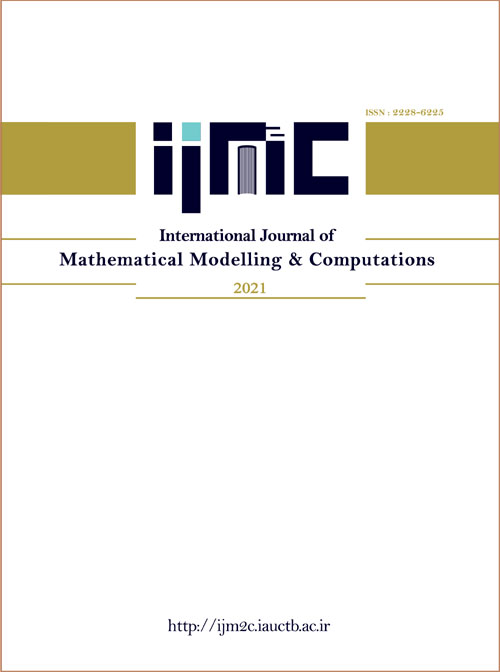فهرست مطالب

مجله بین المللی محاسبات و مدل سازی ریاضی
سال یازدهم شماره 3 (Summer 2021)
- تاریخ انتشار: 1400/10/18
- تعداد عناوین: 6
-
-
Page 1
This given paper can be considered as a continuation of previous work, doing on cancer models and their control by a set-valued method, in the context of viability theory. We analyze a class models of ordinary differential equations, taking into account the possibility to directly acting on tumor. However we can augment the class by a simple ordinary differential equation of the tumor control term, and join it to the other variables state. This will allow to exploit results to generalize the approach.
Keywords: Anti-angiogenic therapy, Chemotherapy, Viability theory, Set-valued analysis -
Page 2
Hexavalent chromium pollutants in water are the most challenging of human health according to current situations. From many treatment methods, the adsorption method is the best alternatives for hexavalent chromium removal from wastewater. Activated carbon and biosorption are the basic adsorbents in the adsorption process. In these review and model optimization there where many articles reviewed under activated carbons and biosorption without carbonizing. The basic factors for the two adsorbents are adsorbent dose, pH value, and contact time at around room temperature. Maximum removal efficiency allocated at the acidic condition, these show the –OH releasing state is at the acidic condition. According to articles reviewed, the efficiency of bio- sorbent was greater than activated carbon. There were similarity adsorption efficiency of activated carbon and biosorption. As reviewed activated carbon and biosorption preparation, activated carbon preparation was more energy consumption than biosorption preparations. The model optimization also summarised and optimum condition of maximum removal efficiency where specified.
Keywords: hexavalent chromium, Activated Carbon, bio adsorbent, optimizations, parameters -
Page 3
Recommender system based on collaborative filtering (CF) suffers from two basic problems known as cold start and sparse data. Appling metric similarity criteria through matrix factorization is one of the ways to reduce challenge of cold start. However, matrix factorization extract characteristics of user vectors & items, to reduce accuracy of recommendations. Therefore, SSVD two-level matrix design was designed to refine features of users and items through NHUSM similarity criteria, which used PSS and URP similarity criteria to increase accuracy to enhance the final recommendations to users. In addition to compare with common recommendation methods, SSVD is evaluated on two real data sets, IMDB &STS. Experimental results depict that proposed SSVD algorithm performs better than traditional methods of User-CF, Items-CF, and SVD recommendation in terms of precision, recall, F1-measure. Our detection emphasizes and accentuate the importance of cold start in recommender system and provide with insights on proposed solutions and limitations, which contributes to the development.
Keywords: Recommender Systems, singular value decomposition, Cold start, SSVD, similarity measure -
Page 4
In this paper, we consider a system of viscoelastic wave equations of Kirchhoff type with delay and logarithmic nonlinearity. We obtain the local existence of solution by using the Faed-Galerkin approximation and under suitable conditions, we prove the blow up of solutions in finite time.
Keywords: Wave Equation, Local existence, blow up, logarithmic nonlinearity, Delay -
Page 5
Choosing a response surface design to fit certain kinds of models is a difficult task. Extensive research comprising a collection of efficient second-order response surface designs from which a researcher may choose to best fit his/her needs has been conducted, which are based solely on a widely-accepted assumption of a completely randomized error structure of statistically-designed experiments. However, this assumption is not feasible in industrial experiments, which are often split-plot in nature and for which randomization of some factors have to be restricted due to certain constraints. The performance of such experimental designs depends strongly on the relative magnitude (d) of the whole-plot and sub-plot error variances. This work focuses on reduced second-order models having one, two, or all of their quadratic and/or interaction terms removed from the full models of some chosen candidate split-plot central composite designs (CCDs). It investigates the effects of model reduction on efficiency of these designs by computing the relative D-efficiencies for the formulated reduced models with respect to their corresponding full designs and assessing the efficiency losses under specific values of d. The study revealed a significant loss of D-efficiency in these designs, which depend strongly on the removed term(s) and increases, across all values of d, as the number of whole-plot factors increases.
Keywords: Relative D-Efficiency loss, Split-plot design, Design optimality criteria, Reduced Models -
Page 6
In the present paper, we have focused on the antiviral treatment of avian influenza to predict the situation of the disease and analyzed the stability of the model at the equilibrium points (disease-free and endemic). In this concern, we have applied the SITR model based on the well-known SIR model to calculate the basic reproduction number and final size relation. Important parameters, such as susceptible, infective, treatment, and removal (SITR) rate under the compartmental method have been studied theoretically. The analytical results highlight that the model results are locally and globally stable at disease-free equilibrium if the basic reproduction number is less than one and it is locally and globally stable at endemic equilibrium if the basic reproduction number is greater than one. The numerical simulations of the developed model (SITR) are performed graphically with the help of the Range-Kutta method and we have also observed that each compartment has much affected by the infection and death rate, whereas re-susceptive has no significant effect on compartments.
Keywords: Avian influenza, Treatment, Drug resistance, Stability, Jacobi matrix, Lyapunov

